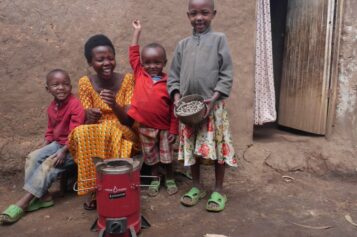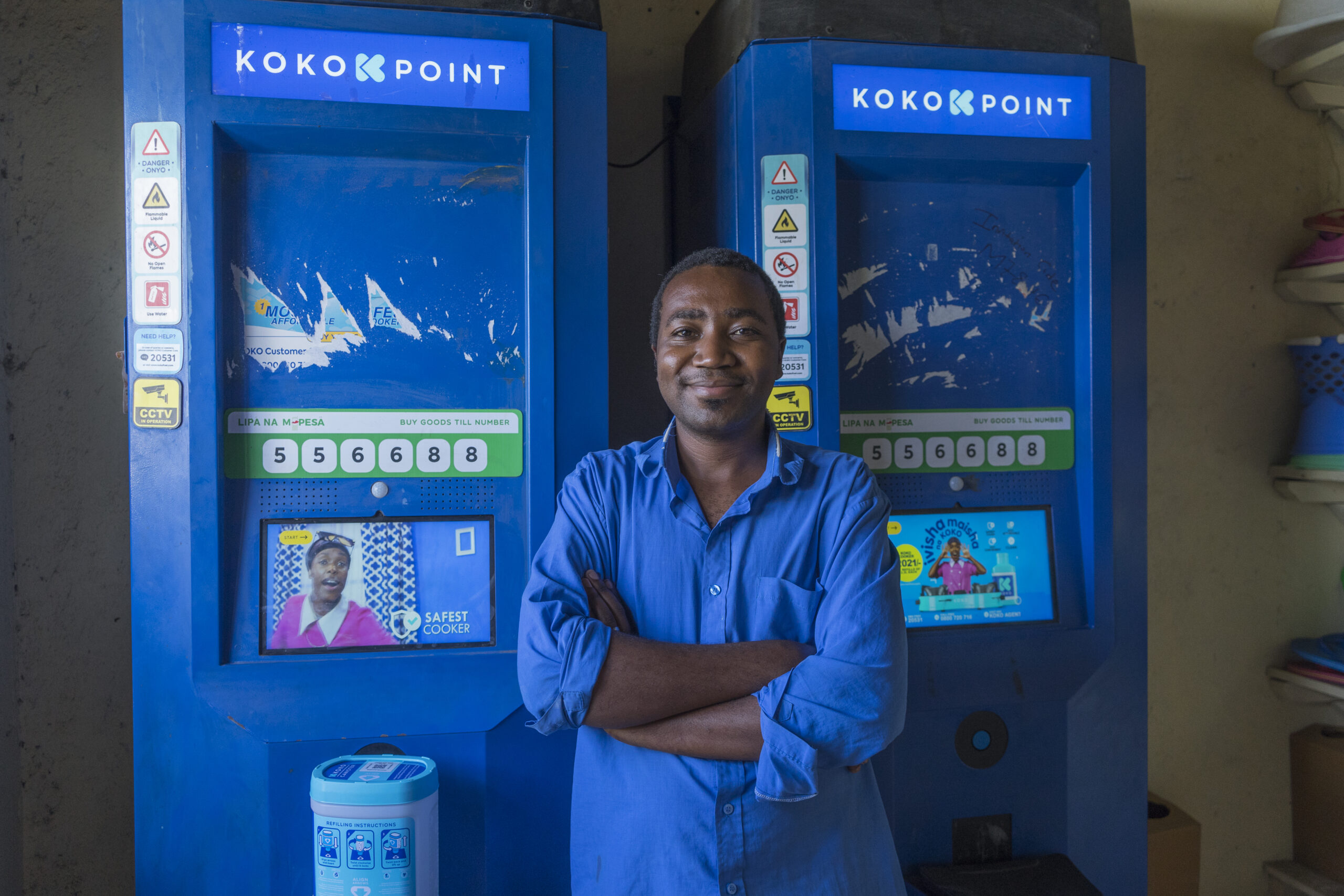
40.3M (76%)
Clean cooking population without access (WHO, 2021)
30
Active clean cooking ventures (Source: CCA)
5
Number of clean cooking RBF (Source: CCA)
Despite continued high use of solid biomass, Kenya’s cooking sector is considered by some to be the most advanced in East Africa in terms of both the types of solutions available and the number of people with access to them.
A range of clean cooking technologies are manufactured and distributed by companies in the formal sector in Kenya. These solutions span improved efficiency biomass stoves (using charcoal or wood as fuel), and stoves that rely on clean liquid fuels (biogas, ethanol, and LPG). Despite increasing levels of electricity connections even in rural areas, electric cooking remains low with potential to grow. Solar cooking remains rare in Kenya.
According to World Bank data, 23.9% of the population had access to clean fuels and technologies for cooking in 2021; an improvement on the ratio of 12.1% with access in 2015. In 2021, 51.3% of the urban population had access to clean cooking fuels, compared with just 8.3% of the rural population.
Compared with access to clean cooking fuels and technologies, there is much better access to electricity in Kenya; 76.5% of the population had access in 2021, up from 41.6% in 2015.
Click ‘Read more’ to see data from World Bank.
According to the Kenya Consumer Segmentation report (see related resources below), almost eight-in-ten Kenyan households primarily use solid cooking fuels, primarily wood (63%) and charcoal (15%). In rural areas, 84% of households use wood as their primary source of cooking fuel.
Related Resources
Click ‘Read more’ to explore relevant aspects of Kenya’s Nationally Determined Contributions and other current policies that are relevant to clean cooking.
Nationally Determined Contributions
Kenya’s NDC integrates their commitment to clean energy technologies with the aim of reducing overreliance on wood fuels by 2028. The National Climate Change Action Plan 2018-2022 also prioritizes the promotion of the transition to clean cooking with alternative clean fuels such as LPG in urban areas and clean biomass (charcoal and wood) cookstoves and alternatives in rural areas.
However, the distribution and use of improved biomass cookstoves are not enforced by any government law, policy, or regulation, and there is no obligation for households to use improved cookstoves. Kenya seeks to implement its NDC with both domestic and international support, estimating that over USD 40 billion will be required for mitigation and adaptation actions.
The NDC Support Program in Kenya will be implemented jointly with the USAID-supported Low Emissions and Climate Resilient Development (LECRD) project, with the goal of supporting the implementation of Kenya’s NDC. Strategic partnerships among various ministries, departments, and agencies working with the UNDP and other stakeholders will be enhanced to achieve this goal. The program is also engaged in a range of strategic partnerships at the global level.
Other Relevant Policies
The clean cooking sector in Kenya experienced a significant policy-related setback in June 2020 when the Finance Act, 2020 was signed into law with the reinstatement of 16% VAT on previously exempted clean cooking items. Te revised custom duties became effective as of July 1st, 2020 and are shown in the table below. LPG was granted a one-year extension of zero-rating, but the change in its VAT status was enacted in July 2021. The Government of Kenya provided VAT exemptions to some technologies including biogas, ethanol and briquettes, but improved cookstoves and LPG were not exempted.
A key policy objective of the Kenyan government is to meet the SDG 7 target for universal access to modern cooking solutions by 2028. This deadline was initially in 2030 but was brought forward during the 2019 Clean Cooking Forum to reflect the issue’s elevated prioritization within the government. Kenya intends to achieve this goal with 42% adoption of clean cooking fuel use (mostly LPG, but also allowing for biogas, ethanol, and electricity), while solid fuel-improved cookstoves would be required to serve the needs of the remaining 58%.
This table shows the latest Kenyan Duty and VAT for clean cooking items, as of FY 2021/2022:
| Description | Custom Duty | VAT |
|---|---|---|
| LPG cylinders | 25% | 0% |
| Biomass cookstoves | 25% | 16% |
| Gas cookers | 10% | 14 % |
| Ethanol for cooking | 25% | VAT exempt |
| LPG gas | 0% | 16% (From July 2021) |
| Inputs for the manufacture of energy-saving stoves | 0% | VAT exempt |
| Electric stoves | 25% | 16% |
| Pre-fabricated biogas kits | 0% | VAT exempt |
| Biogas | 0% | VAT exempt |
| Briquettes | 0% | VAT exempt |
| Kerosene | 0% | 8% |
Several policy actions aim to support progress towards the SDG 7 target for universal access to modern cooking solutions. Among the most notable, the National Energy Policy of 2018 aims ‘to facilitate provision of clean, sustainable, affordable, competitive, reliable and secure energy services at least cost while protecting the environment’. Kenya’s National Climate Change Action Plan aims to reduce greenhouse gas emissions by 7.1 MtCO2e by 2022, largely through the uptake of alternative fuels and more efficient cookstoves. Key aims of the plan are to increase the number of households using improved biomass cookstoves by 4 million, construct 7,100 digesters for domestic and institutional use, and promote alternative cooking solutions such as LPG and ethanol.
Kenya has 74 cookstove projects registered in it. These projects have generated 11.8 million carbon credits to date.
Click ‘Read more’ to explore the dashboard.
There are five clean cooking RBF programs that have operated, or are underway, in Kenya.
Click ‘Read more’ to explore the table of RBFs.
| Name | Lead | Status | Dates | Applicable Fuels | Fund size for clean cooking | Total fund size |
| RBF for low carbon energy access | EnDev | Completed | 2012-2020 | e-cooking, improved biomass, biogas | $15m | $55m |
| Kenya Off-Grid Solar Access Project (KOSAP) | SNV, SunFunder | Active | 2018-2023 | Improved biomass | $5m | $5m |
| SDG 7 RBF Facilities | Netherlands Enterprise Agency (RVO) | Active | 2019-2026 | Improved biomass | $14.6m | $24.4m |
| Renewable Energy and Climate Technologies (REACT) | AECF | Active | 2021-2023 | Improved biomass, pellets, briquettes, ethanol, and LPG. | $1.7m | $4m |
| Modern Cooking Facility for Africa (MCFA) | Nefco | Active | 2022-2027 | e-cooking, biogas, pellets, briquettes, and ethanol | $30.5m | $30.5m |
N.B. Funding amounts may be split across multiple countries












